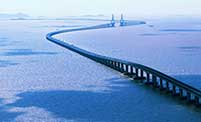

BEIJING, Dec. 22 -- As China strives to sustain growth, supply-side reform is the latest tool to be taken from the box and sharpened.
While supply-side economics, as a macroeconomic theory, is nothing new, China's supply-side reforms have some unique features.
Q: What is supply-side management?
A: Supply-side economics holds that the best way to stimulate economic growth is to lower barriers to production, particularly through tax cuts. The wealth-owners, rather than spending on direct "demand" purchases, will then be more enticed to invest in things that increase supply, such as new businesses, innovative goods and services.
To fully understand the supply side, it is easier to first understand the demand side.
China's three decades of rapid growth were fueled by capital investment, exports and consumption, usually thought of as being on the demand side.
In 2008, following the subprime crisis in the United States, China pushed out a 4-trillion-yuan (620 billion U.S. dollars) stimulus package. The rationale was that pouring money into public works, principally infrastructure projects such as highways and railways, creates jobs and stimulates demand for construction materials like steel and cement. Wages paid to workers are, in turn, spent on necessities and business keeps going.
While this kind of stimulus can keep an economy afloat in times of crisis, problems such as overcapacity and rising home prices emerge. During the infrastructure frenzy, difficult issues such as income distribution were put on the back burner.
Q: What are the reforms?
A: Compared to stimulating demand, which tends to be short-lived, supply-side management is expected to generate sustainable, quality growth.
The Chinese economy is no longer galloping ahead on the back of investment, exports and consumption.
Adjusting banking regulations and interest rates has not been very successful in boosting investment or consumption.
With growth falling below 7 percent, China's economy is in dire need of a makeover. Instead of working on the demand side, attention has turned to stimulating business through tax cuts, entrepreneurship and innovation while phasing out excess capacity resulting from the previous stimulus. Such measures are intended to increase the supply of goods and services, consequently lowering prices and boosting consumption.
Q: Is supply-side management a substitute for demand-side management?
A: No. Attending to the supply side, albeit belatedly, does not reduce the importance of demand-side management, partly because stimulating the supply side takes time. Enterprises do not become more vibrant, efficient and productive overnight.
President Xi Jinping said last month that China should work more on the supply side "while moderately expanding overall demand." The same line appeared in a statement released on Monday following the Central Economic Work Conference. Demand-side management is not going away.
Q: What are China's concrete supply-side reforms?
A: Cutting housing inventories, tackling debt overhang, eliminating superfluous industrial capacity, cutting business costs, streamlining bureaucracy, urbanization and abandoning the one-child policy are all examples of supply-side reforms.
Viewed as a whole, these measures can also be considered "structural" reform. By cutting capacity, nurturing new industries and improving the mobility of the populace, vitality and productivity should increase.
 Are these the world’s scariest landing strips?
Are these the world’s scariest landing strips? In pics: Left behind children in China
In pics: Left behind children in China Eight modern day engineering marvels of China
Eight modern day engineering marvels of China Chinese beauty with sexiest bottom
Chinese beauty with sexiest bottom Charming female bodybuilders of Chengdu University
Charming female bodybuilders of Chengdu University Polish sports stars strip off for risqué calendar
Polish sports stars strip off for risqué calendar Spectacular aerial photos of the Three Gorges
Spectacular aerial photos of the Three Gorges Contestants of Mrs. Globe pose for photo in Shenzhen
Contestants of Mrs. Globe pose for photo in Shenzhen
 Bikini models attend hot pot banquet in Hefei
Bikini models attend hot pot banquet in Hefei Top 20 hottest women in the world in 2014
Top 20 hottest women in the world in 2014 Top 10 hardest languages to learn
Top 10 hardest languages to learn 10 Chinese female stars with most beautiful faces
10 Chinese female stars with most beautiful faces China’s Top 10 Unique Bridges, Highways and Roads
China’s Top 10 Unique Bridges, Highways and RoadsDay|Week